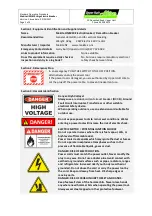
BOP-1K-GL 111315
3-45
3.7.4.3
QUERY INDICATOR
The question mark (?) following a keyword is a query indicator. This changes the command into
a query. If there is more than one keyword in the command, the query indicator follows the last
keyword. (e.g., VOLT? and MEAS:CURR?).
3.7.4.4
DATA
Some commands require data to accompany the keyword either in the form of a numeric value
or character string. Data always follows the last keyword of a command or query (e.g.,
VOLT:LEV:TRIG 14 or SOUR:VOLT? MAX
3.7.4.5
DATA SEPARATOR
Data must be separated from the last keyword by a space (e.g., VOLT:LEV:TRIG 14 or
SOUR:VOLT? MAX
FIGURE 3-10. MESSAGE STRUCTURE
3.7.4.6
MESSAGE UNIT SEPARATOR
When two or more message units are combined in a program message, they must be separated
by a semicolon (;) (e.g., VOLT 15;MEAS:VOLT? and CURR 12; CURR:TRIG 12.5).
3.7.4.7
ROOT SPECIFIER
The root specifier is a colon (:) that precedes the first keyword of a program message. This
places the parser at the root (top left, Figure 3-9) of the command tree. Note the difference
between using the colon as a keyword separator and a root specifier in the following examples:
:CURR:LEV 3.5;:OUTP ON;:CURR?<NL>
MESSAGE TERMINATOR
KEYWORD
QUERY INDICATOR
ROOT SPECIFIER
MESSAGE UNIT SEPARATOR
DATA
KEYWORD
KEYWORD
KEYWORD SEPARATOR
KEYWORD
MESSAGE UNIT SEPARATOR
DATA
MESSAGE UNIT
DATA SEPARATOR
DATA SEPARATOR
ROOT SPECIFIER
INITIAL ROOT
SPECIFIER IS
OPTIONAL
Summary of Contents for BOP-GL 1KW
Page 2: ......
Page 10: ......
Page 20: ...x BOP 1K 111315 FIGURE 1 1 HIGH POWER BOP GL SERIES POWER SUPPLY...
Page 36: ...1 16 BOP 1K GL 111315 FIGURE 1 3 BOP OUTPUT CHARACTERISTICS...
Page 38: ......
Page 116: ......
Page 128: ......
Page 174: ......
















































